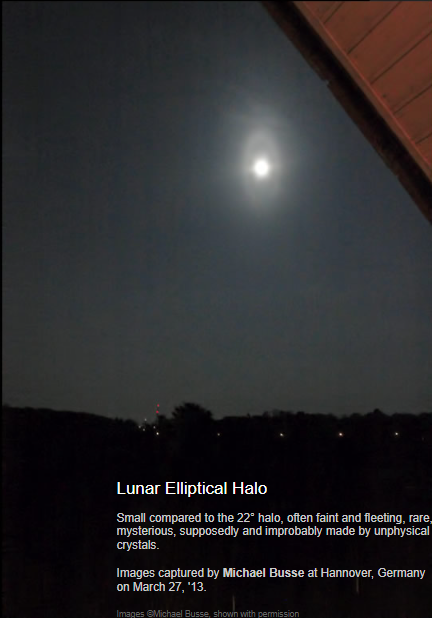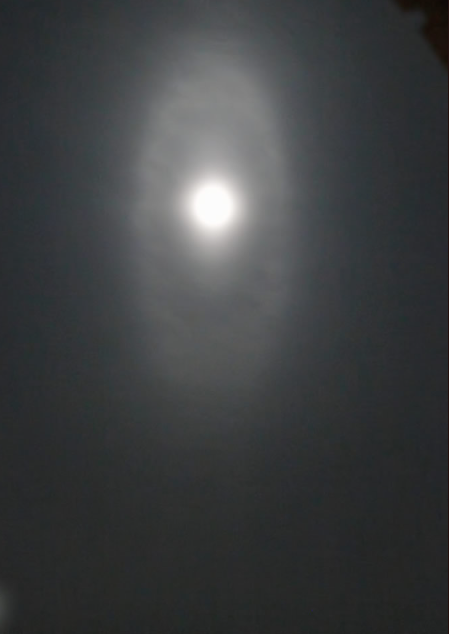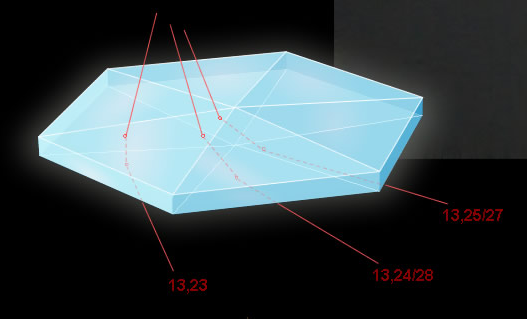OPOD - Hannover Elliptical
OPOD - Hannover Elliptical: A Mysterious Lunar Phenomenon
Have you ever witnessed a faint and fleeting optical phenomenon in the night sky, so rare and mysterious that it captivated your imagination? One such captivating phenomenon is the Lunar Elliptical Halo, which is small compared to the more commonly observed 22° halo. This elusive phenomenon is supposedly created by unphysical crystals, adding to its enigmatic nature. In this article, we will delve deeper into the intriguing world of the Hannover Elliptical and explore its general behavior, variation with sun/moon altitude, and the multiple rings it exhibits.
The Hannover Elliptical was captured on March 27, '13, by Michael Busse in Hannover, Germany. The images, shown with his permission, showcase the ethereal beauty of this lunar phenomenon. However, despite its allure, the scientific understanding of the Hannover Elliptical remains incomplete. While crystals are often invoked to explain the general behavior and multiple rings observed, the intricate details of its formation are still not well understood.
The Hannover Elliptical displays a variety of characteristics that vary with the altitude of the sun or moon. As the celestial body rises higher in the sky, the elliptical halo tends to become more prominent. This variation suggests a correlation between the angle of incidence and the intensity of the phenomenon. However, the exact mechanism behind this relationship is yet to be fully explained.
One possible explanation for the formation of the Hannover Elliptical involves the presence of crystals in the atmosphere. These crystals, unlike those responsible for other optical phenomena like halos and rainbows, possess unique properties that give rise to the elliptical shape. However, further research is needed to determine the exact nature of these crystals and how they interact with light to create such a distinct phenomenon.
It is worth noting that the Hannover Elliptical is a rare occurrence, making it even more intriguing to scientists and skywatchers alike. Its fleeting nature adds an element of unpredictability to its observation, as it may appear and disappear within a short span of time. This rarity also presents a challenge for researchers attempting to study the phenomenon in detail, as they must rely on fortuitous sightings and captured images to gather data.
The Hannover Elliptical is not the only elliptical halo that has been observed in the atmosphere. Similar phenomena have been reported in various locations around the world, each with its own unique characteristics. The existence of multiple elliptical halos suggests that there may be different mechanisms at play, contributing to the formation of these enigmatic optical phenomena.
In conclusion, the Hannover Elliptical remains a captivating and mysterious lunar phenomenon. While crystals are believed to play a role in its formation, the intricate details of its behavior and the specific properties of these crystals are yet to be fully understood. The rarity and fleeting nature of this phenomenon make it a fascinating subject for further research and observation. By unraveling the secrets behind the Hannover Elliptical, scientists can deepen our understanding of atmospheric optics and uncover the hidden wonders of the night sky.

Lunar Elliptical Halo
Small compared to the 22° halo, often faint and fleeting, rare, mysterious, supposedly and improbably made by unphysical crystals.
Images captured by Michael Busse at Hannover, Germany on March 27, '13.
Images ©Michael Busse, shown with permission


The general behaviour of ellipticals, their variation with sun/moon altitude and their several rings, can be explained by invoking crystals like these. However, the devil is in the details and they are not well explained.
Note: this article has been automatically converted from the old site and may not appear as intended. You can find the original article here.
Reference Atmospheric Optics
If you use any of the definitions, information, or data presented on Atmospheric Optics, please copy the link or reference below to properly credit us as the reference source. Thank you!
-
<a href="https://atoptics.co.uk/blog/opod-hannover-elliptical/">OPOD - Hannover Elliptical</a>
-
"OPOD - Hannover Elliptical". Atmospheric Optics. Accessed on May 2, 2024. https://atoptics.co.uk/blog/opod-hannover-elliptical/.
-
"OPOD - Hannover Elliptical". Atmospheric Optics, https://atoptics.co.uk/blog/opod-hannover-elliptical/. Accessed 2 May, 2024
-
OPOD - Hannover Elliptical. Atmospheric Optics. Retrieved from https://atoptics.co.uk/blog/opod-hannover-elliptical/.